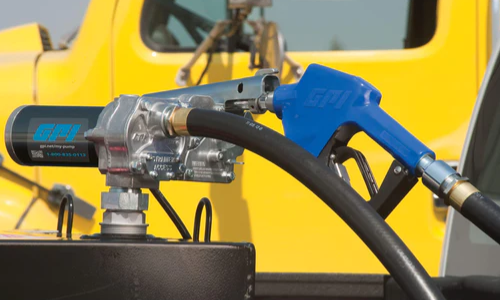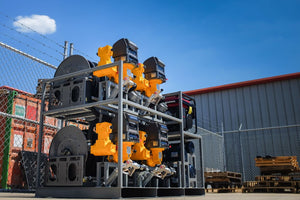
HOW TO CHOOSE THE BEST FUEL TRANSFER PUMP FOR YOUR APPLICATION
With so many fuel transfer pump options, how do you pick the right one? This series of simple questions will narrow down your choices and lead you to the best fuel transfer pump for your application.
1. WHAT TYPE OF WORK WILL YOU DO WITH YOUR FUEL TRANSFER PUMP?
First, you need to determine whether you need a Standard Duty or Commercial Duty/Heavy Duty fuel transfer pump. Will you be refueling small equipment like lawn mowers and recreational vehicles, or will you be fueling heavy equipment out in the field?
Examples of standard duty use include:
- landscape/lawn service (lawn mowers)
- small farms (small tractors and equipment)
- ATVs/snowmobiles
- racing/automotive
- electrical/plumbing contractors
Examples of commercial duty/heavy duty use include:
- construction sites
- large farms/farm equipment
- logging
- mining operations
- oil exploration

WHY IS IT IMPORTANT TO CHOOSE THE RIGHT PUMP?
Commercial duty pumps, like GPI’s GPRO line, have higher flow rates and larger motors to meet the demands of heavy duty industrial and agricultural use. They’re designed to fill large gas tanks quickly and can stand up to the most rugged conditions. Standard duty pumps are engineered and constructed to be used with more day-to-day use.
2. WHAT POWER SOURCE WILL YOU USE TO OPERATE THE PUMP? WILL YOU USE A MOBILE OR FIXED TANK INSTALLATION?
Will you have access to your building’s electrical service to run your pump? Or, will you need a battery-powered pump to refuel out in the field?
Electric fuel transfer pumps come in two basic types:
- 12V DC power for mobile applications (like a tank in a truck bed)
- 115V AC power for fixed applications (like an above-ground fuel storage tank)
In commercial duty lines, you will also see mobile 24V DC and fixed 230V AC pumps.
The fuel transfer pump you choose MUST match your power supply. You can’t power a 115V pump effectively with a 12V battery. On the flip side, trying to power a 12V pump with a 115V power supply will not only damage the pump, but is dangerous.
If you don’t have access to a power supply, you need a hand pump. These simple-to-use and economical pumps transfer fluid safely and cleanly. Choose the method of transfer you prefer (lever action piston pump, diaphragm pump or rotary action pump) and check the features to make sure it works with the type of fluid you want to transfer. The GPI HP-100 is a premium hand pump for gasoline and diesel fuels that generates twice the flow of other models.

3. WHAT TYPE OF FLUID DO YOU NEED TO TRANSFER?
Now that you know the basic type of fuel transfer pump you need, it’s time to look at the features of individual models to see what types of fluids they transfer. Not all pumps work for all fluids.
MOST FUEL TRANSFER PUMPS HANDLE GASOLINE, DIESEL, ETHANOL AND KEROSENE.
HOWEVER, OTHER PUMPS ARE DESIGNED FOR LUBRICANTS AND HIGH-VISCOSITY FLUIDS LIKE MOTOR OIL, TRANSMISSION FLUID AND ANTIFREEZE. MAKE SURE THE PUMP YOU SELECT MATCHES THE FLUID YOU NEED TO TRANSFER.
4. HOW OFTEN WILL YOU USE YOUR FUEL TRANSFER PUMP? WHAT SIZE OF THE EQUIPMENT FUEL TANK WILL YOU BE FILLING?
Will you use your fuel pump occasionally or every day? Is time a factor when refueling? Will you be filling a 3-gallon tank on a riding lawnmower, or a 300-gallon gas tank on a combine?
Your answers to these questions will determine the flow rate you need for your pump. Flow rate is measured in gallons per minute (GPM)—the higher the GPM rating, the less time it will take to refuel. If your pump’s GPM rating is too low for your tank size, it will take a long time to refuel. Get one that’s too high, and you can have spillage or frothing when refueling.

Also consider whether you want a manual or automatic nozzle. An automatic nozzle has an automatic shutoff feature for hands-free refueling. This feature costs more than manual, but may well be worth it in the long run if it frees you up for other tasks.
LOOKING FOR SPECIFIC FUEL TRANSFER PUMP RECOMMENDATIONS?
This Easy Selection Guide gives you specific fuel transfer pump recommendations for your application, power source and tank size. It even offers recommendations for corresponding meters and fuel storage tank sizes.

